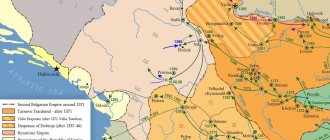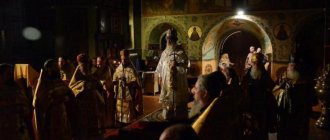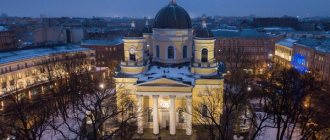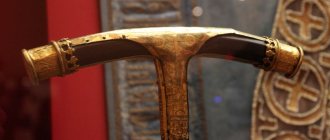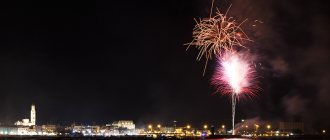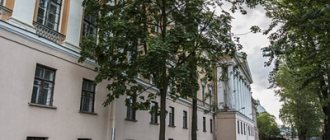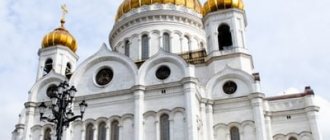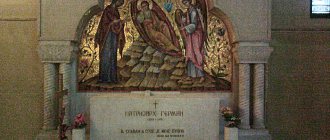| New York Znamensky Synodal House Cathedral and the first hierarch's residence |
Russian Orthodox Church Outside of Russia
, a self-governing Church within the Moscow Patriarchate
- Official site:
- Canonical territory: diaspora: most represented in the USA, to a lesser extent in Germany, Canada, Australia; also valid in other countries of Western Europe, South America, Asia and New Zealand; in the canonical territory of several local Churches is in charge of its dioceses, institutions and parishes
- Liturgical language: main Church Slavonic and English; in accordance with the needs of the parishes German, French, Spanish, Indonesian, etc.
- Calendar: Julian
- Cathedral: Znamensky in New York (first hierarchal residence at the cathedral)
- Primate: Hilarion, His Eminence Metropolitan of Eastern America and New York
- Composition: 17 bishops; 9 dioceses; 409 parishes (2013) [1]; 39 monasteries (2013) [1]; 2 higher theological schools (1 institute, 1 seminary); ? members
- On the map: Yandex.Map, Google map
Dioceses
- Eastern American
- Berlin
- Geneva
- Caracas
- Montreal
- Richmond
- San Francisco
- Sydney
- Chicago
Historical sketch
Emergence
The October Revolution of 1917 and the subsequent Russian Civil War led to the disruption of normal communications between many parts of the former Russian Empire and to a mass exodus of Orthodox believers from Russia.
The fronts of the civil war, the borders of the newly formed seceded states and enemy states divided the previously united space. By the early 1920s, approximately 3-4 million refugees and emigrants were scattered throughout the world, and more than 8 million Orthodox Christians found themselves outside the newly formed Soviet state. The hierarchy of the Russian Orthodox Church, being concentrated in Moscow in the very center of the Soviet state, faced great difficulties in trying to continue the spiritual care of the cut-off flock; at that time, information about the state of affairs in different parts of the former empire and the whole world was difficult to access and incorrect. The clergy who found themselves outside Soviet territory could also have only a vague idea of what was happening in the Soviet country. Under these conditions, the first attempts arose to form an administration for the parts and children of the Russian Church who found themselves abroad. Its history goes back to the Stavropol Council on May 19-24, 1919, which organized the Temporary Higher Church Administration of the South-East of Russia for parts of the Russian Orthodox Church that found themselves in the territory occupied by Denikin’s white troops. In November 1920, members of the Directorate left Russia. The most authoritative hierarchs who left Russia—Metropolitan of Kiev and Galicia Anthony (Khrapovitsky), Archbishop of Volyn and Zhitomir Evlogiy (Georgievsky)—initially intended to seclude themselves in monasteries and stop the activities of the Administration, leaving the care of the Russian flock abroad to the corresponding Local Churches, but then they changed solution. According to the biographer of Metropolitan Anthony, he decided to change his plans and preserve the Russian church organization after he learned of General Wrangel’s intention to maintain a military organization to fight the Bolsheviks.
On November 19, 1920, the first meeting of the Management outside Russia took place on the ship “Grand Duke Alexander Mikhailovich” in the port of Constantinople. The hierarchs, led by Metropolitan Anthony, decided to continue their activities among the emigrants. The decree issued by the Locum Tenens of the Patriarchal Throne of Constantinople, Metropolitan Dorotheos of Brus in December 1920, authorized the activities of the Office on the territory of the Patriarchate of Constantinople under the subordination of the supreme authority of the patriarch, who retained, in particular, judicial prerogatives.
Foreign hierarchs saw the canonical basis for their activities in emigration in Canon 39 of the VI Ecumenical Council - a view expressed in the article by Professor S. V. Troitsky “On the rights of bishops who lost their chairs without their fault.” Another document, often mentioned abroad as the basis for the activities of foreign Church Administration, was the decree of November 20, 1920 No. 362 of Patriarch Tikhon, the Holy Synod and the Supreme Church Council, which prescribed the temporary organization of the “highest authority of church authority” in cut off dioceses in conditions of disruption messages. As an indirect recognition of the new Administration on the part of St. Tikhon, the bishops abroad accepted his decree No. 424 of April 8, 1921, which confirmed the temporary appointment of Archbishop Eulogius (Georgievsky) as administrator of Russian parishes in Western Europe, initially made by the Supreme Church Administration in October 1920, back in period of stay in Crimea.
On May 12, 1921, the Supreme Church Administration moved from Constantinople to the territory of the United Kingdom of Serbs, Croats and Slovenes, whose government extended hospitality to the Russian emigrants, and Serbian Patriarch Dimitri lovingly welcomed the Russian archpastors and provided them with his residence in Sremski Karlovci. On August 31, 1921, the Council of Bishops of the Serbian Orthodox Church granted the Supreme Church Administration the right of jurisdiction over Russian clergy not serving in the Serbian Church.
The Supreme Church Administration at that time was recognized by the majority of over 30 Russian bishops who found themselves abroad. At the same time, in order to strengthen their canonical position, foreign archpastors repeatedly tried to contact Saint Tikhon. In particular, in July 1921, Metropolitan Anthony submitted a report to the Patriarch with a proposal to establish the Supreme Administration of the Russian Church Abroad, uniting all foreign Russian parishes and dioceses of the Moscow Patriarchate, including Finland, the Baltic states, Poland, North America, Japan and China, under the chairmanship of the Patriarchal Vicar . A blessing was also asked for convening a foreign meeting of the Russian Church. However, on October 13, 1921, Patriarch Tikhon, the Holy Synod and the Supreme Church Council of the Russian Orthodox Church recognized the establishment of the position of the Patriarchal Vicar as inappropriate “as not caused by anything”; the Supreme Church Administration was left “with its previous powers”, without extending its scope to Poland and the Baltic states , and the message about the upcoming meeting was taken into account.
On November 21, 1921, the All-Church Foreign Assembly of bishops, clergy and laity opened in Sremski Karlovci, which during the meetings was renamed the All-Diaspora Council. The message of the Council “To the Children of the Russian Orthodox Church, in Dispersion and Exile” contained a call for the return of the legitimate Orthodox Tsar from the House of Romanov to the Russian throne. A message sent on behalf of the Council to the international Genoa Conference, scheduled for April 1922 to discuss issues of Russian public debts, called on all peoples of the world to support the military campaign against the Soviet state with weapons and volunteers. These appeals were used by the Soviet authorities to intensify the persecution of the Church in Russia and radically changed the relations of the foreign center with the Moscow Patriarchate. The documents adopted in Karlovtsy contradicted the principle of non-interference of the Church in political affairs [2]. The authorities in Moscow demanded that St. Tikhon defrock foreign bishops, but the patriarch did not want such measures. On May 5, 1922, Decree No. 348 (349) of Patriarch Tikhon, the Holy Synod and the Supreme Church Council followed, according to which the messages of the Karlovac Council were recognized as not expressing the official voice of the Russian Orthodox Church and, due to their purely political nature, having no canonical significance. In view of political statements made on behalf of the Church, the Higher Church Administration abroad was abolished, and power over parishes in Europe was retained by Metropolitan Eulogius. The question was also raised about the church responsibility of clergy abroad for their political statements made on behalf of the Church.
The day after the decree was signed, Patriarch Tikhon was arrested. Information about the arrest of the saint came abroad before the decree, by the time it was received the schismatic-renovationists had already made an attempt to usurp power in the Russian Church. As a result, most of the representatives of the foreign episcopate feared that legitimate church authority in Russia had been completely destroyed. Largely for this reason, Decree No. 348 was implemented only formally. The Council of Russian Bishops Abroad on September 2, 1922 abolished the Supreme Church Administration, but instead formed a temporary Synod of Bishops headed by Metropolitan Anthony. The archpastors cited Decree No. 362 of November 20, 1920 as the basis for this decision. Foreign bishops considered that the decree gave the right to create a church organization outside the canonical territory of the Russian Orthodox Church, where its dioceses had not previously existed. The Abroad Council of Bishops in June 1923 confirmed the decision to create the Synod.
After the death of Saint Tikhon on March 7, 1925, foreign bishops did not immediately recognize the authority of the Patriarchal Locum Tenens Hieromartyr Peter (Polyansky), which was largely caused by uncertainty abroad regarding his intentions towards the Renovationists. On April 9, 1925, the Synod of Bishops of the Russian Church Abroad considered it appropriate,
“in the event that the Soviet government in Russia will not allow the election of a new patriarch, but will, through violence and deception, impose and strengthen the power of the Renovation Synod or rape the archpastoral conscience of the locum tenens or the new patriarch, grant the Chairman of the Synod of Bishops, His Eminence Metropolitan Anthony, with the rights of a temporary one, until the convening of a canonical of the All-Russian Holy Council, Deputy Patriarch, to represent the All-Russian Orthodox Church and, as far as conditions and circumstances allow, to lead church life and the Church not only outside Russia, but also in Russia"
. However, in the fall of the same year, the Synod of Bishops suspended the validity of this definition, since Metropolitan Peter’s speeches against the Renovationists convinced foreign bishops to recognize his powers as a patriarchal locum tenens.
The relations of foreign archpastors with the deputy patriarchal locum tenens, Metropolitan Sergius (Stragorodsky), who headed the Russian Church after the arrest of Metropolitan Peter on December 10, 1925, were initially confidential. However, after the proposal to bishops in Western Europe to sign a pledge of loyalty to the Soviet regime, as well as after the publication of the Message to the shepherds and flock of Metropolitan Sergius and the temporary Patriarchal Synod of July 29, 1927 (the so-called “Declaration of Metropolitan Sergius”), Synod of Bishops 5 September 1927 decided to interrupt communication with the deputy patriarchal locum tenens. The District Message of the Council of Bishops of the Russian Orthodox Church Abroad dated September 9, 1927 stated:
“The message of Metropolitan Sergius is not archpastoral or ecclesiastical, but political, and therefore cannot have church-canonical significance and is not necessary for us, free from the oppression and captivity of God-hating and Christ-hating authorities... Such a decree cannot be recognized as legal and canonical.”
.
The Council, from which by that time Metropolitans Eulogius and Platon had already separated with the parishes they headed in Western Europe and North America, decided to cease relations with the Moscow church authorities, continuing to recognize the patriarchal locum tenens Metropolitan Peter, who was in exile, as the head of the Russian Church. At the same time, the District Message states that
“The foreign part of the Russian Church considers itself an inextricable, spiritually united branch of the great Russian Church. She does not separate herself from her Mother Church and does not consider herself autocephalous.”
.
In a break with the hierarchy in Moscow
After 1927, communication between the hierarchy of the Church in the Fatherland and hierarchs abroad was interrupted for many decades. In 1934, the deputy patriarchal locum tenens, Metropolitan Sergius (Stragorodsky), issued a decree banning Metropolitan Anthony (Khrapovitsky) and several foreign hierarchs from the priesthood. The Synod of Bishops of the Church Abroad did not recognize this resolution. After the death of the First Hierarch of the Russian Church Abroad, Metropolitan Anthony, in 1936, the division continued under his successors. In August 1938, the Second All-Diaspora Council took place in Sremski Karlovci.
During the Second World War, some of the representatives of the Russian Church Abroad expressed hope for the liberation of Russia from the rule of the Bolsheviks by force of arms. Other archpastors, on the contrary, expected the victory of the Red Army and saw Russia’s victory in this. Thus, the Bishop of Shanghai, St. John (Maximovich), collected money for the needs of the Red Army and served thanksgiving prayers after its victories over the Nazis; Archbishop of Bogucharsky Seraphim (Sobolev), who ruled the Russian parishes in Bulgaria, categorically refused to bless Russian emigrants for the fight against Russia. At the end of the war, on August 10, 1945, Patriarch Alexy I of Moscow and All Rus' addressed a message to foreign archpastors and clergy, where he called on them to unity with the Moscow Patriarchate, and many archpastors heeded him [3], significantly reducing the number of adherents of the Foreign Synod. It is worth noting that His Holiness Patriarch Alexy I of Moscow and All Rus', while in Yugoslavia in 1945, celebrated a memorial service for Metropolitan Anthony.
At the same time, the Synod of Bishops continued its activities. During the war he left Sremski Karlovci, from 1946 he was in Munich, and from 1950 in New York. Immediately after the war, a number of bishops-refugees from the USSR joined him.
Remaining in rupture with the Church in the Fatherland, the Church Abroad retained an understanding of itself as an inextricable part of the Russian Church, temporarily alienated by the force of external circumstances. This was expressed in the Regulations on the Russian Orthodox Church Outside of Russia, adopted in 1956, in which it is defined as
“an inseparable part of the local Russian Orthodox Church, temporarily self-governing on conciliar principles until the abolition of godless power in Russia”
.
Saint John (Maximovich) of Western America and San Francisco said:
“Every day at the proskomedia I remember Patriarch Alexy. He is the patriarch. And our prayer still remains. We are cut off by circumstances, but liturgically we are united. The Russian Church, like the entire Orthodox Church, is united Eucharistically, and we are with it and in it. But administratively, for the sake of our flock and for the sake of certain principles, we have to follow this path, but this in no way violates the mysterious unity of the entire Church.”
.
In the mid-1960s, Archbishop John wrote: “The Russian Church Abroad is not spiritually separated from the suffering Mother.
She offers prayers for her, preserves her spiritual and material wealth, and in due time will unite with her, when the reasons separating them disappear .
For decades, the Russian Church Abroad diligently preserved the traditions of Orthodox piety, dating back to pre-revolutionary Rus', and was actively engaged in publishing and educational activities. Monastic life also continued. The monastery of St. Job in Ladomirova (Czechoslovakia), founded in 1923, became a new embodiment of Pochaev monastic traditions. In 1946, the brethren of the monastery moved to the United States of America, where they joined the Holy Trinity Monastery in Jordanville (New York), founded in 1930. The Holy Trinity Monastery became the main spiritual center of the Russian Church Abroad. The Holy Trinity Theological Seminary was founded here in 1948, which became the spiritual and educational center of the Church, and the publishing business that had begun in the monastery of St. Job was resumed here. Through the efforts of the brethren, many newspapers, magazines and books were published, some of which were sometimes transported to Russia with great difficulty. Where in Soviet times the publication of spiritual literature was extremely limited, such works by authors from the Russian Church Abroad were well known, such as “The Law of God” by Archpriest Seraphim Slobodsky, “Commentary on the Four Gospels” and “Commentary on the Apostle” by Archbishop Averky (Taushev), “ Dogmatic theology” by Protopresbyter Michael Pomazansky.
Under the First Hierarch, Metropolitan Philaret (Voznesensky), the Third All-Diaspora Council took place in September 1974 at the Holy Trinity Monastery in Jordanville, and a number of glorifications were also performed - the holy righteous John of Kronstadt (November 13, 1964), the Venerable Herman of Alaska (July 25/26, 1970 year), Saint Blessed Xenia (September 24, 1978), and, the most important of them, the Holy New Martyrs and Confessors of Russia (November 1, 1981).
During the years of disunity with the Church in the Fatherland, the Russian Church Abroad fenced itself off from communication with the majority of other Local Orthodox Churches, insisting on the unacceptability of false ecumenism and complaining about the deviation of the majority of Churches from the Church’s Julian calendar. At the same time, the Church Abroad has always been in Eucharistic communion with the Serbian Orthodox Church.
Restoring the unity of the Russian Orthodox Church
The beginning of the end of the atheist regime and the revival of the Church in Russia was marked by the solemn celebration in 1988 of the 1000th anniversary of the Baptism of Rus'. The Local Council of 1988 canonized Patriarch Tikhon and a number of ascetics, and churches and monasteries began to gradually return to the Church. These changes gave hope for a speedy restoration of unity and members of the Local Council of 1988 called on the Church Abroad to negotiate, but in 1990, despite the disagreement of a number of archpastors, the Bishops' Council of the Russian Church Abroad decided to open parishes of its jurisdiction on the canonical territory of the Moscow Patriarchate, which again strained relations.
In 1991, the USSR disappeared and a new opportunity for rapprochement opened up. In October of this year, Patriarch of Moscow and All Rus' Alexy II, in an open letter to participants in the Congress of Compatriots, said:
“The outer shackles of aggressive godlessness that bound us for many years have fallen. We are free, and this creates the preconditions for dialogue, for it was the freedom of our Church from the oppression of totalitarianism that was the condition for meeting with foreign brothers and sisters, which the Hierarchy of the Russian Church Abroad has repeatedly spoken about.”
.
A certain stage in the development of the dialogue was the regular interviews that began in 1993 between representatives of the Moscow Patriarchate, headed by Archbishop Feofan of Berlin and Germany, and clergy of the Berlin diocese of the Russian Church Abroad, headed by Archbishop Mark. In the joint statement of the participants in the last, ninth interview, held in December 1997, Fr. Beginning in the 1990s, Bishop Laurus (Shkurla), who played a central role in the reunification, began his regular unofficial visits to Russia to familiarize himself with the reality of its church life. In 1994, at the Council of Bishops of the Russian Church Abroad in Lesna, it was decided to begin rapprochement with the Moscow Patriarchate. However, the First Hierarch of the Church Abroad, Metropolitan Vitaly, again suspended the process of rapprochement, and the alienation of the property of the Church Abroad in the Holy Land strained relations, once again delaying the healing of the division.
An important milestone on the path to unity was the Jubilee Council of Bishops of the Russian Orthodox Church, held in Moscow in August 2000. The Council glorified the new martyrs and confessors of Russia, adopted the “Fundamentals of the social concept of the Russian Orthodox Church,” which clarified the position of the Moscow Patriarchate in relation to state power, and “Basic principles of the attitude of the Russian Orthodox Church to heterodoxy,” which clearly set out the vision of interfaith dialogue. Patriarch of Moscow and All Rus' Alexy II in his report called the division between the Church in the Fatherland and the Church abroad “the historical tragedy of the Russian people” and called on the Russian Church Abroad for unity. The decisions of the Council were positively received in the Russian Church Abroad, and the retirement of Metropolitan Vitaly and the elevation of Bishop Laurus to the first hierarchical see opened the way to rapprochement.
On September 24, 2003, a meeting between the President of the Russian Federation V.V. Putin and Metropolitan Laurus took place at the Russian Consulate General in New York. President Putin gave Metropolitan Laurus a letter from Patriarch Alexy, and also, on his own behalf and on behalf of the Patriarch, invited Metropolitan Laurus to visit Russia. In November 2003, an official delegation of the Russian Church Abroad visited Moscow, negotiations took place during which the parties expressed their will to establish prayerful and Eucharistic communion and decided to create commissions designed to help resolve the problems that had accumulated over the years of separation. In December 2003, these commissions were created and the All-Diaspora Pastoral Conference of the Russian Church Abroad was held to discuss issues of church unity, in which clergy of the Moscow Patriarchate also took part. In their address, the participants of the Pastoral Conference stated that they welcome steps towards the unity of the Russian Church. A significant event was the visit to Russia of the delegation of the Russian Church Abroad led by its First Hierarch, Metropolitan Laurus, on May 14-27, 2004 - the first official visit of the First Hierarch of the Russian Church Abroad during all the years of division. During the pilgrimage visits and interviews, a deeper mutual understanding was achieved, and the symbolic event of the visit was the joint laying of the foundation stone by Patriarch Alexy and Metropolitan Laurus of the temple at the site of the mass executions at the Butovo training ground, which took place on May 15. Detailed work on discussing and understanding the problems dividing the Church was carried out by commissions of both sides, meeting in Moscow (DECR, June 22-24, 2004), Munich (September 14-17, 2004), Moscow (November 17-19, 2004), and the outskirts of Paris (2-24). March 4, 2005), Moscow (July 26-28, 2005), Nyack (New York, February 17-20, 2006), Moscow (June 26-28, 2006) and Cologne (October 24-26, 2006).
In October 2004, the Council of Bishops of the Russian Orthodox Church was held, which approved the already achieved results of the work of the commissions, and in May 2006, the IV All-Diaspora Council, held in San Francisco, fundamentally approved the course towards unity. The commissions completed their work in November 2006, having during this time developed draft documents defining the canonical status of the Russian Church Abroad within the Moscow Patriarchate, the attitude of the parties to the problems of relations between the Church and the state, the Orthodox Church and heterodoxy. All these documents were subsequently approved by the Holy Synod of the Russian Orthodox Church and the Synod of Bishops of the Russian Orthodox Church Abroad. Simultaneously with the negotiations, the Moscow Patriarchate and the Russian Church Abroad carried out a number of joint initiatives, indicating that the unification is finding a lively response among the Orthodox flock. Despite the seemingly strong opposition among a considerable part of the foreign flock, under the prayerful and wise leadership of Metropolitan Laurus, the Church Abroad was able to approach reunification, losing only a very few children. Finally, on May 17, 2007, in the Moscow Cathedral of Christ the Savior, the solemn signing of the Act on Canonical Communion between the Moscow Patriarchate and the Russian Church Abroad took place by the Patriarch of Moscow and All Rus' Alexy II and the First Hierarch of the ROCOR, Metropolitan Laurus of Eastern America and New York, after the signing of which the first joint worship.
The management and life of the Russian Orthodox Church Outside of Russia is regulated by the Statute of the Russian Orthodox Church Outside of Russia.
Notes[ | ]
- The Odessa and Zaporozhye diocese of the ROCOR announced the termination of the commemoration of Metropolitan Laurus. Church-scientific.
- The Odessa and Zaporozhye dioceses of the ROCOR(L) officially announced the termination of the commemoration of Metropolitan Laurus during divine services. Tsarkva.
- Notification from the Bishop of Tauride and Odessa Agafangel (Pashkovsky) in connection with the entry of part of the ROCOR into the Moscow Patriarchate.
- Pavel Krug.
“Odessa Schism” in the Church Abroad
(undefined)
.
www.ng.ru
(June 6, 2007). - ↑ 1 2 Pavel Krug.
Deepening the split / Facts and comments / Nezavisimaya Gazeta
(undefined)
.
www.ng.ru
(July 18, 2007). - Documents of the meeting of representatives of ROCOR parishes, held at Holy Trinity Church in Astoria, New York, USA. see protocol 3.
- DOCUMENT: Minutes of the meeting of Russian parishes of the ROCOR chaired by Bishop Agafangel dated June 6, 2007.
- Archived copy (unspecified)
(inaccessible link). Date accessed: December 13, 2021. Archived June 21, 2021. - Documents of the meeting of representatives of ROCOR parishes, held at Holy Trinity Church in Astoria, New York, USA
- ↑ 12
Message from the Provisional Central Administration of the ROCOR to all the faithful children of the Russian Church Abroad - Pavel Korobov
.
Holy discord. An alternative to the Church Abroad has been created, kommersant.ru
, Kommersant, No. 128 (July 21, 2007), P. 3. - Fund for Relief of the Russian Orthodox Church Abroad
- RussianOrthodoxChurchAbroad-OfficialPage
- DOCUMENT: Act on the basic principles of joint work of Greek and Russian anti-ecumenists, adopted by the deputy. Chairman of the “Synod of Opposition” of the TOC of Greece and Chairman of the All-Russian Orthodox Church of the Russian Orthodox Church Abroad portal-credo.ru December 6, 2007
- ↑ 12
The All-Russian Orthodox Church Abroad accepted the “Sekachev” bishops into its jurisdiction, approved the agenda of the V All-Diaspora Council and restored the Conference of Russian Eminences portal-credo.ru on September 9, 2008. - History of the “Seraphim-Gennadievsky” branch of the “Russian Catacomb Church”
- 5th All-Diaspora Council
- Article about the V All-Diaspora Council of the ROCOR by His Grace Clement Bishop of Gardinsky, honorary guest of the Council (Greek Old Calendar Church)
- Report of the Chairman of the All-Diaspora Council to the V All-Diaspora Council
- To the Synod of Bishops of the ROCOR
- The Council of Bishops of the ROCOR(A) formed a new composition of the Synod of this Church and abolished the Conference of Russian Eminences on April 29, 2010.
- Bishop Irenaeus (Klipenstein), who ruled the Western European Diocese of the RTOC, transferred to ROCOR(A) on June 18, 2010.
- The reordination of “Metropolitan” Nikolai (Modebadze) as “Bishop of Potino” took place
- Mikhail Pletnev Self-saints from “ROCOR(A)”, “UOC-KP” and “BAOC” create an ecumenical international // Russian People's Line
- Results of the meeting of the Synod of Bishops of the ROCOR (Ag) on May 27, 2011
- Archpriest Vsevolod Chaplin: The activities of N. N. Antonenko contradict the teachings of the Orthodox Church / News / Patriarchy.ru
- After the trial, the sect of Nadezhda Antonenko united with the schismatic ROCOR(Ag)
- The first, after a long break, liturgy was celebrated in the church in Cannes (unspecified)
(inaccessible link). Access date: December 18, 2013. Archived December 16, 2014. - The parish of the ROCOR(A) in Cannes, which won the case of ownership of the Church of the Archangel Michael two years ago against the ROC MP, decided to transfer to the Patriarchate of Constantinople - Portal-Credo...
- Appeal to the “old foreigners”: Let’s replenish the number of those who have fallen away! (unspecified)
(inaccessible link). Date accessed: September 21, 2021. Archived August 29, 2021. - ROCOR: Answer of Metropolitan Agafangel to the Synod of the Orthodox Church of Greece. (unspecified)
(inaccessible link). Retrieved November 13, 2014. Archived November 13, 2014. - ROCOR: List of acts of the Extraordinary Council of Bishops. Archived from the original on December 5, 2014.
- https://www.anti-raskol.ru/pages/2622
- Hierarchy of churches | Russian Orthodox Church Abroad (Conference of Bishops)
- DOCUMENT: “We are forced to switch to temporary self-government of ROCOR parishes in Russia”
- “Metropolitan” Agafangel (Pashkovsky) commented on the separation of two bishops and several Russian parishes from the ROCOR(Ag)
- ↑ 12
Synod of Bishops - DOCUMENT: Official communication on the admission into the ROCOR(A) of the former bishop of the ROCOR(V-V) Anastasy (Surzhik)
- Bishop Anastasy (Surzhik), who transferred from ROCOR(V-V) to ROCOR(A), following the results of the meeting of the Far Eastern Diocese, changed his decision (unspecified)
. www.portal-credo.ru. Access date: October 22, 2015. - Acts of the Synod of Bishops
- https://astoriaholytrinity.org/documents/Fr_Oleg_Dopolneniye.pdf
- Metropolitan Agafangel: Address to members of the Holy Trinity Parish in Astoria - Internet Sobor (unspecified)
(inaccessible link). Retrieved July 21, 2021. Archived July 25, 2021. - https://astoriaholytrinity.org/documents/2016_06_24_Andr_Ukaz_1.pdf
- https://astoriaholytrinity.org/documents/2016_06_26_summons_to_court.pdf
- https://vishegorod.ru/download/PUBLISH-ME.pdf
- https://astoriaholytrinity.org/documents/2016_07_09_vl_andronik_to_synod.pdf
- Bishops' Council of Russian Law
- The official organ of the ROCOR(A) and books in Ukrainian have been added to the Federal List of Extremist Materials of the Russian Federation - Credo.Press
- Bishops of the ROCOR (A)
First Hierarchs
- Anthony (Khrapovitsky) (November 19, 1920 – 1936) Metropolitan. Kyiv and Galitsky
- Anastasy (Gribanovsky) (August 10, 1936 – May 27, 1964) Metropolitan. Chisinau and Khotyn, then Eastern American and New York
- Filaret (Voznesensky) (May 31, 1964 – November 21, 1985)
- Vitaly (Ustinov) (February 4, 1986 – June 10, 2001)
- Laurus (Shkurla) (July 10 - October 21, 2001) deputy, archbishop. Syracuse
- Hilarion (Corporal) (March 16 - May 12, 2008) supreme, archbishop. Sydney
Dioceses[ | ]
ROCOR(A) includes 15 dioceses and one vicariate[49]
- New York and Eastern American - Metropolitan Agafangel (Pashkovsky)
- Sao Paulo and South American - Bishop Gregory (Petrenko)
- Syracuse and Nikolskaya - Bishop Grigory (Petrenko)
- Ottawa and North American - Bishop Grigory (Petrenko)
- Lyon and Western European Diocese - Metropolitan Agafangel (Pashkovsky)
- Melbourne and Australian - Bishop John (Schmelz).
- Tauride and Odessa - Metropolitan Agafangel (Pashkovsky)
- Chisinau and Moldova - Archbishop George (Kravchenko)
- Buinskaya and Volzhskaya - Archbishop John (Zaitsev)
- Vologda and Veliky Ustyug - Bishop Afanasy (Savitsky)
- Voronezh and South Russian - Bishop Kirill (Kravets)
- Moscow - Metropolitan
Agafangel (Pashkovsky) Kolomna Vicariate of the Moscow Diocese - Bishop Ambrose (Timrot)
Nikon (Iost)
former bishops
- Bishop Dionysius (Alferov), b. Novgorod and Tverskoy
- Bishop Irenaeus (Klippenstein), b. Vernensky and Semirechensky (Kyrgyzstan and Kazakhstan, with the exception of its northern regions)
- Archbishop Sophrony (Musienko), b. St. Petersburg and North Russian
- Archbishop Andronik (Kotlyarov), b. Ottawa and Canadian
deceased bishops
- Bishop Joseph (Grebinka), b. Washington (died September 19, 2020)
- Bishop Anfim (Tudos), Bassarabia, vicar of the Chisinau diocese (died October 24, 2021)
Shrines
The main shrine of the Russian Church Abroad, the miraculous Kursk-Root Icon of the Mother of God, taken from Russia in 1920, is kept in the Znamensky Church at the Synod of Bishops in New York. The icon is often transferred for veneration to various dioceses and parishes of the Russian Church Abroad. The relics of the holy martyr Grand Duchess Elisaveta Feodorovna and nun Varvara, killed by the Bolsheviks in 1918, are also a precious shrine. The remains of the venerable martyrs were transported to Jerusalem in 1921, where they now rest in the Church of St. Mary Magdalene.

